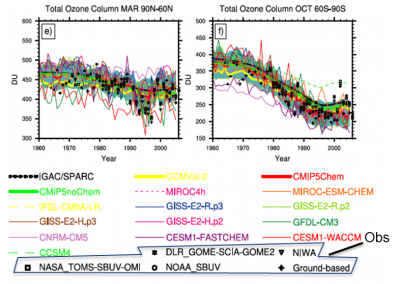Long-Term Ozone Changes and Associated Climate Impacts in CMIP5 Simulations
Stratospheric ozone depletion has been found to play a prominent role in recent climate change, with impacts on stratospheric temperatures and the Southern Hemisphere tropospheric circulation and surface climate. For future projections, the interplay between the recovery of the Antarctic ozone hole and increasing greenhouse gases could in addition have important long-term implications for CO2 uptake in the Southern Ocean and changes to Antarctic ice sheets. This study undertakes a multimodel assessment of ozone and associated climate impacts in the new set of CMIP5 models, which includes for the first time a number of fully coupled transient chemistry-climate simulations. Only with these simulations can the sensitivity of future ozone to the new Representative Concentration Pathways (RCPs) scenarios be evaluated. In contrast to CMIP3, where half of the models prescribed constant stratospheric ozone, all CMIP5 models consider past ozone depletion and future ozone recovery. Multimodel mean climatologies and long-term changes in total and tropospheric column ozone are in reasonable agreement with observations. Stratospheric ozone projections show largest differences across the four RCPs in the northern midlatitudes and in the Arctic in spring with some super-recovery of ozone over the Arctic, whereas the recovery of the Antarctic ozone hole is far less sensitive to variations in greenhouse gases. Large variations in stratospheric ozone, particularly in CMIP5 models with interactive chemistry, drive correspondingly large variations in lower stratospheric temperature trends. The results also illustrate that future SH summer-time circulation changes are controlled by both the ozone recovery rate and the rate of GHG increases, emphasizing the importance of simulating and taking into account ozone forcings when examining future climate projections.

